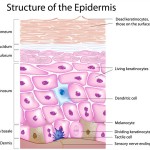 You have probably heard that your skin is the largest organ in your body and that it is a semi permeable membrane. But that doesn’t mean that anything you put on your skin goes right through it.  It is actually pretty hard for most substances to be absorbed through your skin. Pharmaceutical companies spend lots of money on research to try to make transdermal patches to deliver medicine, but there are very few on the market. Absorption through the skin is influenced by the size of the molecules of the substance, the concentration applied, how long it stays on your skin, other ingredients that can be added to aid absorption, the region of the body where it is applied, the condition of the skin, age, gender and race.
You have probably heard that your skin is the largest organ in your body and that it is a semi permeable membrane. But that doesn’t mean that anything you put on your skin goes right through it.  It is actually pretty hard for most substances to be absorbed through your skin. Pharmaceutical companies spend lots of money on research to try to make transdermal patches to deliver medicine, but there are very few on the market. Absorption through the skin is influenced by the size of the molecules of the substance, the concentration applied, how long it stays on your skin, other ingredients that can be added to aid absorption, the region of the body where it is applied, the condition of the skin, age, gender and race.
Your skin is made up of four layers and is about 0.05 inches thick or should I say thin?  The deepest layer (Basale layer) is where skin cells are made and they gradual migrate to the outermost layer called the Stratum Corneum). In between are the Stratum Granlosum and Stratum Spinosum. The Stratum Corneum is what you see when you look at your skin. What you actually see is tough, hard, dead skin cells (called corneocytes), which form a protective barrier, something like a brick wall. This protective layer is not only responsible for protecting against pathogens it also helps regulate temperature, maintains hydration and prevents water loss. These cells are surrounded by a natural oil layer called lipids, sort of like the mortar in the brick wall.  The corneocytes cells don’t have a blood supply and are held together by proteins. These proteins disintegrate over time and release the dead skin cells, exposing and replaced by the cells underneath. When these cells fall off irregularly it can create something like mountains and valleys, leaving your skin feeling rough and patchy. You can help to alleviate this feeling by applying creams or butters that fill in the gaps left between the intact cells.
This shedding of dead skin cells happens naturally but can become a problem when the natural skin oils are depleted through the use of harsh skin care products, too much exfoliation, ultraviolet radiation, climate changes, dehydration and hormonal levels. Disruption in this layer can make it more permeable to pathogens, allergens and dehydration and cause a variety of skin problems.